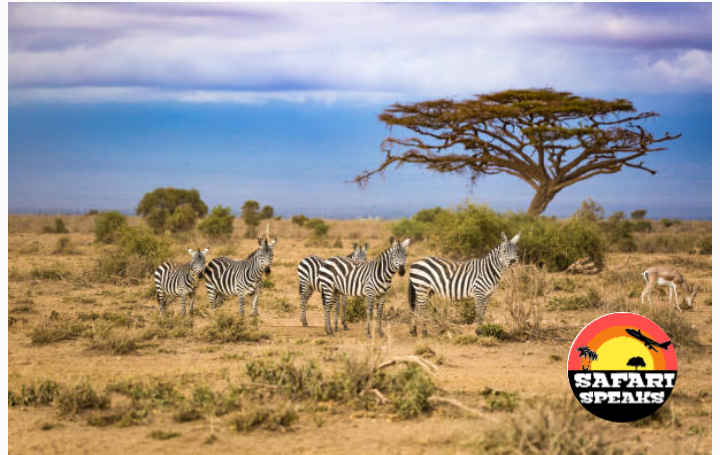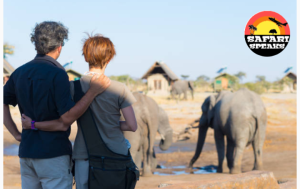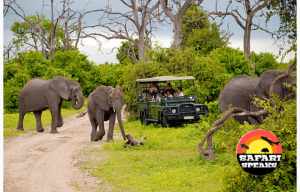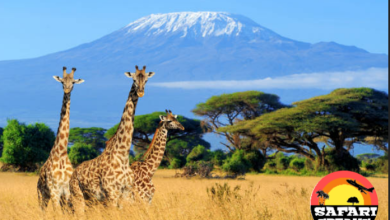Safari Around Botswana: Facts In A Glance And Wildlife Areas

Safari around Botswana can be fun and interesting especially when you go there well prepared for the trip and with full confidence that you will have an exciting stay in Botswana.
The best-selling book, The Cry of the Kalahari, and the hilarious feature films, The Gods Must Be Crazy have assisted Botswana and safari around Botswana in gaining recognition both locally and international as one of the top safari destinations.
More than four-fifths of the country is covered by the Kalahari sands, scrub savannah and grasslands. The land is basically flat with a mean elevation of 3280 feet. Over 85 percent of the population is concentrated near the better water resources in the eastern part of the country.
The Kalahari Desert is not a barren desert of rolling dunes as one might imagine. It has scattered grasslands, bush, shrub and tree savannah, dry river beds, and occasional rocky outcrops.
The ‘Pula’ is Botswana’s unit of currency, and also the Setswana word for rain, which is so critical to this country’s wealth and survival. The rainy season is December to March with the heaviest rains in January and February. Winter brings almost cloudless skies.
January (summer) temperature range from an average maximum of 92 degree Fahrenheit to an average minimum of 64 degree Fahrenheit. Frost occasionally occurs in midwinter.
The San, Basarwa, or Bushmen were the first inhabitants of the area and may have come to Southern Africa 30,000 visited by international travelers. Most camps are serviced by small aircraft, allowing visitors to minimize time viewing wildlife and a variety of other activities the counties has to offer.
Game viewing by air is usually quite fruitful. On one flight from the Savuti to the Okavango Delta, we spotted four large herds of elephant, among numerous other species. Most charter flights have weight limits of 22-30 pounds per person, so bring only what you need.
Safari Around Botswana: Exploring Okavango Delta
The Okavango, the largest inland delta in the world covers over 40000 square miles and is in itself a unique and fascinating ecosystem. Instead of finding its way to the ocean and most rivers do, the Okavango River fans out into a vast system of thousands of waterways, separated by innumerable islands, to eventually disappear into the Kalahari Sands.
Game viewing for the larger land mammal species should not be your main reason for visiting the Okavango. Big game exists in the delta, but is less commonly seen than in Chobe. The main reason for visiting the Okavango should be to explore the wonder of this inland delta, to enjoy the primordial silence, the unusual flora, the birdlife, hippo, crocs and excellent fishing.
However, this is not to say that large land mammals are encountered in the delta. Large herd of buffalo and a variety of antelope are often seen; lion and other predators are occasionally encountered.
Game viewing is actually quite good on Chief’s Island and the outlying areas of the delta during the cooler months (June to September) when the water is high.
Crocodiles are most heavily concentrated in the larger waterways and in the northern part of the delta where there is permanent deep water. However, crocs are found throughout the delta.
The Okavango has possibly the highest concentration of fish eagles in the world. On numerous occasions our guide waved a fish in the air and called to a fish eagle perched high in a tree over a half mile away, then tossed the fish into the water about 30 feet from the boat. Like magic, the eagle dived down at full speed and plucked the fish from the water. One must be fast with a camera to catch that on film.

Fishing in the Okavango is best in the northwestern part of the delta. The Okavango River above the delta is too heavily fished. The best time of the year for catching tiger fish is October and November. For barbell, the best time is the end of September through October when the barbell is running (migrating). Overall, the best time for fishing is September to March.
Activities in the Okavango include travel by mokoro or canoe, motor boat rides, fishing, walks on islands, and game drives. Where there is access by land, a four-wheel-drive vehicle is necessary.
Elephant back safaris is on African elephants are a new and unique way of experiencing the bush. Guest fly to Abu’s Camp to join Abu, the lead elephant, along with his family, Bennie, Kathy and seven other babies on safari for six days.
Safari Around Botswana: Exploring Tsodilo Hills
Over 2700 bushmen paintings are scattered through the rocky outcrops of Tsodilo Hills, one of the last places in Botswana where bushmen can be readily found. The largest of the four-wheel drive vehicle.
There are no facilities, so travelers must be totally self-sufficient. Unfortunately, this site has become a bit touristic, so don’t expect to see bushmen living as they did thousands of years ago. However, the rock paintings are well worth a visit. Please do not drink anything in the presence of Bushmen- water is scarce.
Moremi Wildlife Reserve
Moremi is the most diversified of all safari around Botswana parks in terms of wildlife and scenery, and many people feel it is the most beautiful. Located in the northeastern part of the Okavango Delta, Moremi contains over 1160 square miles of permanent swamps, islands, floodplains, forests and dry land. In the floodplains reedbuck, common waterbuck, lechwe, tsessebe, ostrich, sable and roan antelope, crocodile, hippo and otter can be found. In the riparian forest you may spot elephant, greater kudu, southern giraffe, impala, buffalo, Burchell’s zebra, along with such predators as lion, leopard, wild dog, ratel (honey badger), spotted hyena, and very rarely, rhinos.
On a morning game drive, we saw two herds of sable antelope, elephant, greater kudu, tsessebe, impala and Burchell’s zebra. On another game drive we spotted seven lions, cheetah, bat eared fox, and several species of fox, and several species of antelope.

That afternoon, we spotted four young tsessebe standing alone under a tree. We approached within about 50 feet of them, but they still held their ground.
Shortly afterwards, a herd of adult tsessebe came about 100 feet of us and stopped. The two groups began communicating, using clicking sounds. A female ran from the adult herd to the juveniles, then ran off into the bush with what we guessed was her calf.
Elephants and buffalo are the only large animals that migrate. After the rain have begun, they move northward to the area between Moremi and the Kwando-Linyanti River system. Other wildlife may move to the periphery of, or just outside, the reserve.
Moremi is an ornithologist’s delight. Fish eagles, king fishers and bee-eaters abound. Other bird species include parrots, shrikes, egrets, jacanas, pelicans, hornbills, herons, saddle-billed storks, yellow-billed woodpeckers, wattled cranes, reed cormorant, spur-winged goose, long-tailed shrike and flocks of thousands of red-billed quelea which fly together in a sphere like a great spotted flying ball.
Moremi is open year-round; however, some areas may be temporarily closed due to heavy rains or floods. That is where the four-wheel drive vehicle becomes important.
Chobe National Park
Safari around Botswana can be very exciting and enriching in knowledge especially when visiting Chobe National Park. It is famous for its large herds of elephant; it covers about 4200 square miles. The park is situated only 50 miles from Victoria Falls in Zimbabwe with the Chobe River forming its northern and northwestern boundaries. Across the river is Namibia’s Caprivi Strip. Birdlife is prolific, especially in the riverine areas.

The four main regions of the park are Serondela in the northeast near Kasane, the corridor around Ngwezumba and Nogatsaa, the Linyanti Swamp in the northwest, and the Savuti in the west.
Game viewing by boat along the Chobe river can be spectacular, especially July-October in the dry season. Often large herds of elephant and a variety of other wildlife come down to the river to drink water. By boat you can get within close range of these animals. Large monitor lizards can be commonly seen.
Along Chobe River between the Chobe Game Lodge and the village of Kasane, you are likely to see numerous hippo, red lechwe, common waterbuck, warthog, and guinea fowl. Driving from the lodge towards Serondela Camp you can usually see giraffe, impala, zebra, and occasionally kudu and Chobe bushbuck.
Safari Around Botswana: How To Maintain Health In Botswana
Tsetse flies have all but been eradicated from the Okavango Swamps. The water in these swamps is free from bilharzia and generally safe to drink. So too is the tap water in all the urban centers and most villages. Hepatitis is rare. There are clinics and health centers. In comparison with many countries in Africa, the public health services are competent and well supplied.




